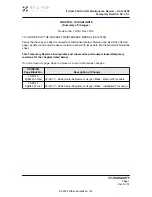
FILTER MANIFOLDS
Main Filter Manifold
The engine-driven hydraulic pumps supply
hydraulic fluid under approximately 3,000
psi to the main hydraulic system filter mani-
fold. This manifold contains supply and re-
turn line filters, two filter differential pressure
switches, two engine pump pressure switches
and a main system pressure transducer. If a fil-
ter becomes blocked, the associated differ-
e n t i a l p r e s s u r e s w i t c h c a u s e s a “ M A I N
FILTER” LED indication to illuminate on the
GSP. There is no cockpit indication of filter
blockage or bypass.
The main filter manifold pressure switches
monitor engine hydraulic pump output pres-
sure, one for each engine pump. These pres-
sure switches generate a white “L or R HYD
PUMP LOW” advisory CAS message should
the corresponding engine pump output fall to
1,900 psi or less. See Figures 13-1 and 13-5.
The pressure transducer, in the main filter
manifold, provides main system pressure in-
formation for display on the EICAS/MFD.
The pressure transducer also provides the
pressure information that generates an amber
“MAIN HYD PRESS” CAS message, if main
system pressure is less than 1,500 psi or
greater than 3,600 psi (Tables 13-1, 13-2 and
Figure 13-5).
Auxiliary Filter Manifold
The auxiliary hydraulic pump supplies hy-
draulic fluid under 3,000 psi to the auxiliary
filter manifold. This manifold contains sup-
ply and return line filters, and filter differen-
t i a l p r e s s u r e s w i t c h e s f o r t h e a u x i l i a r y
hydraulic system. If a filter becomes blocked,
the associated differential pressure switch
causes an “AUX FILTER” indicator to illu-
minate on the GSP. There is no cockpit indi-
cation of filter blockage or bypass.
The aux filter manifold also contains a pres-
sure switch that generates an amber “AUX
HYD PUMP LO” caution message if the pump
is operating and the pump output pressure to
the manifold is less than 1,900 psi.
ACCUMULATORS
Two hydraulic accumulators are installed in the
airplane. They each contain a permanent
precharge that is not serviceable.
One of the accumulators is a main hydraulic
system accumulator (Figure 13-1) that is in-
stalled to absorb and dampen pressure surges
or bumps in the main hydraulic system. It is
located in the tailcone between the fuselage
tank and the tailcone baggage compartment.
The other accumulator is in the brake system
and is located in the lower, left wing root fair-
ing. Its function is to provide reserve hydraulic
pressure for emergency brake operation and for
parking brake operation. The accumulator is
sized to provide at least six applications of
emergency brakes or to hold parking brake
pressure for approximately 48 hours; how-
ever, the airplane should not be left unchocked.
The auxiliary hydraulic pump is used to pres-
surize the brake accumulator to approximately
3,000 psi. A pressure transducer on the brake
accumulator provides accumulator pressure
information for indicators and CAS messages.
Brake accumulator hydraulic pressure is in-
dicated on EICAS/MFD SUMRY (B-ACUM)
a n d H Y D s y s t e m s c h e m a t i c ( B R A K E
ACCUM) displays (Figure 13-4).
If the brake accumulator pressure is less than
1,200 psi or greater than 3,600 psi, an amber
“BRK ACUM PRESS” caution CAS message
is displayed (Tables 13-1, 13-2 and Figure 13-
5).
LANDING GEAR CONTROL
VALVE MODULE
The landing gear control valve module can re-
ceive both main and auxiliary hydraulic sys-
tem fluid (Figures 13-1 and 13-3). This
module contains the hydraulic crossflow valve
that controls which input, main system pres-
L E A R J E T 4 5
P I L O T T R A I N I N G M A N U A L
13-6
FOR TRAINING PURPOSES ONLY
FlightSafety
international
















































